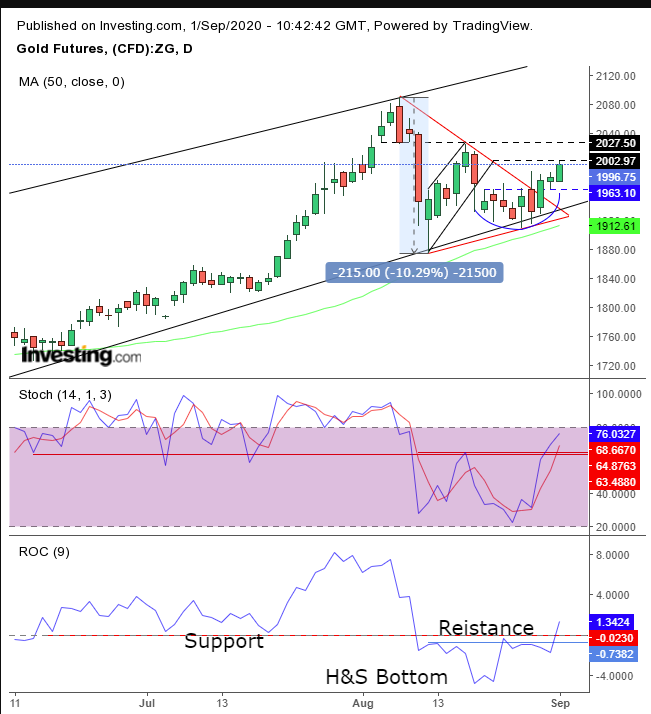One of the functions of the US dollar's status as the global reserve currency is that we quote the value of a variety of financial assets in USD. But like other assets, the greenback's value isn't fixed. Rather, it fluctuates based on a variety of headwinds and tailwinds.
Which brings us to gold. Its value is usually quoted in dollars, and as the buck dips lower, the price of gold is pushed higher. That's the basic, albeit simplified equation.
So when the Fed, along with other central banks, prop up assets by adding liquidity to the markets, making their base currencies cheaper, they render assets more affordable, attracting demand.
But it bears remembering that the precious metal is also a non-yielding asset so it actually has virtually no intrinsic value. Its worth is assigned purely based on the market functions of supply and demand.
As well, gold's sole negative attribute, lack of yield, dissipates, however, when the dollar becomes non-yielding—as is currently the case due to the Fed's lower for longer, near-to-zero rate policy. This leaves gold with only its positive attributes: its limited industrial use, cultural fascination with the shiny metal and its status as a safe haven.
The latter makes it an ideal hedge against record high equities fueled by unprecedented geopolitical uncertainties amid the worst global pandemic in a century that has produced unstable economies and no-longer-reliable energy and real estate markets.
Which changes the yellow metal's supply-demand balance.

After it hit its first record since 2011 in August, we warned of a likely pullback, which was validated via a double-digit correction within just five sessions, from the Aug. 7 high to the Aug. 12 bottom.
Then, the price bounced within a rising congestion that could be proven to be a rising flag, potentially bearish after the 10% plunge that preceded it. However, for now, it appears the demand within the rising channel since the March 12 market bottom is overcoming the drop from the Aug. 7 high.
As of now, it has not turned into a downtrend. Instead, the Aug. 26 low registered above the Aug. 12 bottom, which should have been breached to establish a downtrend.
Negating the bearish view is the hourly rounding bottom (blue). The six-day rally from Aug. 12-19 may seem benign, but it formed a bearish rising flag with related supply-demand implications. However, the rounding bottom helped the daily price complete a pennant which is bullish within the rising channel.
The pennant fits the rising channel like a glove and is supported by the 50 DMA, all complementing each other, forming an overall coherent bullish view. Also, the fact that the demand-projection of the pennant encompasses, and is larger than, that of the rising flag provides bulls the right-of-way, even as any remaining bears wait on the sidelines.
Having said all that, today’s price seems to have found resistance by the flag’s bottom, which may reveal that there are still pockets of supply, remnants of the bearish view that followed the bearish flag. Only upon a decisive close above the $2,027 flag top will the risk be nullified.
Further evidence in favor of the uptrend are bottoms by both the Relative Strength Index and Stochastics.
Trading is the art of weighing risks and navigating accordingly. While we can’t know that the flag won’t turn out to be malignant, we’re betting on what appears to be favorable odds of the continued uptrend as framed within the rising channel. This would retest gold's $2,089.20 record hit on Aug. 7 and beyond, with all the fundamentals helping make the case.
Trading Strategies
Conservative traders would wait for demand to absorb all remaining supply, in order to ease concerns of the end of the rising channel. A possible long entry would be upon a dip that follows the $2,030 penetration.
Moderate traders would risk a long position upon a retracement to the channel bottom with evidence of support.
Aggressive traders may enter a long position at will, provided they write a trading plan that makes it worthwhile. Following is an example.
Trade Sample: Long Position
Entry: $1,975
Stop-Loss: $1,950
Risk: $25
Target: $2,075
Reward: $100
Risk:Reward Ratio: 1:4
Author's Note: This is just a sample, not the analysis. That’s in the post. Trades can be played out in a variety of ways, even by the same trader. The trader may wait for a steeper decline to reduce exposure, which also includes the option of a greater reward. The cost of that added security and/or reward is the potential of missing the trade.
Every trade has a spectrum of possibilities that traders must explore to find what suits them the most. Savvy traders distribute their funds to open multiple positions according to the varying risk and reward levels of the same trade. Good trading!
